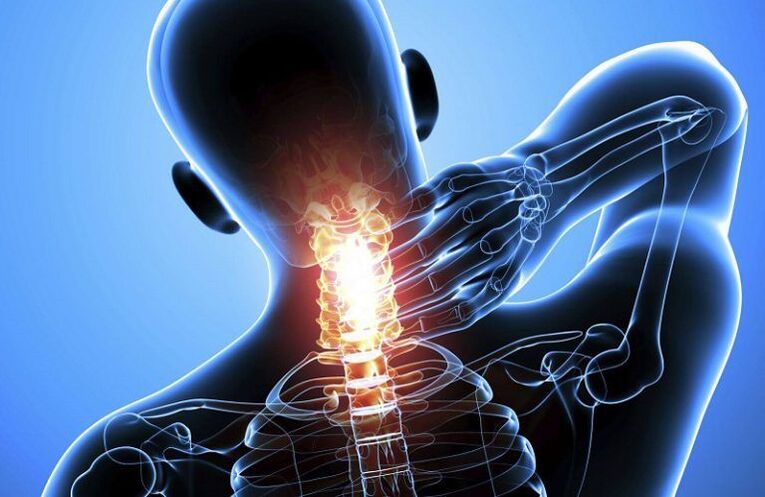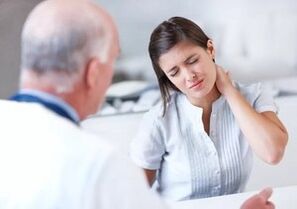Everyone has experienced neck pain more than once in their life. If the back of the neck hurts, then the cause in most cases lies in the cervical spine. Let's take a closer look at each disease.
myositis
Hypothermia and colds develop myositis of the neck - an acute inflammation of the muscles. The person begins to experience severe pain in the neck and shoulder, the temperature rises slightly. On palpation of the painful area, the skin above the muscle is swollen, swollen, hot to the touch. When you try to turn your head to the affected side, there is sharp pain and tension in the muscles of the neck.

Myositis can occur against the background of respiratory or viral disease. Then there is pain in the throat, neck, swollen lymph nodes.
Treatment
Non-steroidal anti-inflammatory drugs will help to quickly and effectively stop the inflammation. Various ointments and gels can be used topically. Here we need to add an important fact about the finalgone - you need to smear it with a thin layer and under no circumstances can be washed off with water.
You can use semi-alcoholic and warming compresses - with vodka, diluted alcohol or dimexid. Folk remedies also help well: boiled potatoes, rubbing with honey, applying crushed cabbage leaves.
In addition to the treatment of myositis, colds are treated - antiviral or antibacterial drugs, vitamins, sprays in the nose and throat. For quick relief of sore throat is a great help spray - a powerful antibacterial and antifungal drug, the effect of which is felt 20-30 minutes after the start of treatment.
Cervical osteochondrosis
Everyone has heard of the disease, but the reasons for its development are still a mystery.
Predisposing factors are injuries, prolonged forced posture, microtrauma of muscles and tendons during heavy physical labor, dystrophic processes in the spine, old age, menopause.

With protrusion, instability, hernia in the cervical spine, compression of the nerve roots occurs, impaired blood flow to the spinal artery, leading to cerebral ischemia.
All symptoms of cervical osteochondrosis are divided into:
- reflex;
- radicular and vascular compression;
- vertebrate.
More ▼:
- Reflex symptoms occur with prolonged irritation of the tissue receptors of the pathological spine. Nerve impulses from the affected vertebra enter the spinal cord, causing changes in the surrounding muscles and tissues. The muscles of the healthy side take over all functions, forming a pathological stereotype of movement. And the muscles of the affected side fix the displaced vertebra in a certain position, preventing its further distortion. But they also do not allow to take a physiological position. If at this time a person does not go to the doctor and chiropractor, muscle atrophy occurs, degenerative changes in the vertebral tissues, cervical osteochondrosis is formed. In the future, the progression of the disease causes inflammation and fibrosis of the muscles of the shoulder girdle, inflammation of the periarticular sac is formed. Reflex symptoms:
- soreness along the spinous processes - palpation of the neck will cause discomfort, pain, shooting in the vertebrae;
- tension and pain in the back muscles of the neck, aggravated by trying to turn the head or probing;
- cervicalgia - pain or sharp pain in the neck, may periodically subside, giving the person a rest. But for loads, long stays in a sitting position (for example during flights, long trips in a bus or car), the pain will not be late. With cervical pain, a person may periodically hear a crunch in the neck, feel discomfort and tingling in the skin;
- cervicocranialgia - heaviness and painful pain in the neck that spreads to the head. The back of the head most often suffers - there is heaviness, a feeling of "pulsation", tingling, a person wants to support his head with his hand or lean on a hard surface. Periodically there are "hot flashes" - it seems that the back of the head and neck are burning or freezing. Sleep also suffers - it is erratic, superficial, in the morning the patient wakes up slow, apathetic, tired. The pain can spread throughout the head - photophobia, shrinking pain in the temples, neck, eyes, high blood pressure, nausea and vomiting often occur;
- cervicobrachialgia - pain in the cervical region spreads to the shoulder and arm. There is pain and spasm of the shoulder muscles, stiffness, pain in the shoulder joint, crunching, difficulty trying to raise or withdraw the arm.
- Compression of the roots and vessels of the spinal cord is manifested by spinal artery syndrome. This is a large complex of different manifestations of spinal vascular compression. There are 3 groups of symptoms that directly indicate the disease:

- throbbing and painful headache of constant or paroxysmal nature, burning, unbearable. Increases in prolonged awkward position, spreads from the nape to the forehead;
- cochleovestibular changes - dizziness, instability when walking, various noises in the ears (clicking, ringing, buzzing). Dizziness in a patient is constant or paroxysmal, worsens the quality of life;
- pathology of vision - darkening and "flies" in front of the eyes, discomfort and a feeling of "sand", burning, decreased vision.
There are several types of vertebral artery syndrome:
Barre-Lieu syndrome - there is pain in the back cervical and occipital area, which passes into the front parts of the head - "removing the helmet". It intensifies at night and after sleep, especially if the person has slept on an uncomfortable pillow. When you turn your head, dizziness and tinnitus, darkening of the eyes appear.
Basilar migraine - before a migraine attack there is darkness in the eyes, blinking black dots, photophobia. The attack begins with severe dizziness, tinnitus, impaired articulation of the tongue (a person has difficulty pronouncing words). Severe pain in the back of the neck, the back of the head, causes a person to assume immobility to reduce the attack. In the midst of the headache, vomiting occurs, in severe cases - fainting.
Cochleovestibular symptom - pain in the back of the neck, crunching when tilting and turning the head, dizziness, hearing loss and impaired speech intelligibility. Often patients cannot distinguish between whispered speech.
Ophthalmic syndrome - on the background of cervical osteochondrosis vision is impaired. A person develops rapid eye fatigue when reading, incoming loss of visual fields, redness of the conjunctiva and tearing.
Spondylarthrosis
The disease is characterized by "wear" of cartilage with bone growths on the edge of the joint surface. The disease occurs at any age, but most often debuts in the elderly. Trauma, inflammation, congenital changes in the joints can cause the development of spondyloarthritis.
Symptoms
The patient is troubled by painful pain in the cervical spine, which is exacerbated by turning and tilting the head. Often a person cannot turn his head completely to the side, trying to increase the range of motion causes back pain. In the supine position the pain subsides. In addition to the neck, the process involves the spinal region, knees and hips.
As the disease progresses, the intervertebral canal narrows in the cervical and lumbar region. Spondylogenic myelopathy develops - a chronic disease of the spine with a weakening of muscle tone and dysfunction of internal organs. Myelopathy provokes an increase in pain in humans, reduces the rate of blood flow in the vessels of the neck and head.
Spondyloarthritis
Prolonged pain in the back of the neck, inability to fully bring the head to the chest - the symptoms may also indicate rheumatoid arthritis of the spine. The disease develops against the background of polyarthritis - many lesions of the joints.
Symptoms
The pain appears in the back of the neck, spreads to the back of the head, intensifies when tilting the head back and forth, turning left and right. One cannot move one's head completely, the neck muscles are tense and sore. In severe cases, a life-threatening complication develops - bulbar syndrome. Its manifestations are diverse and depend on the degree of pinching of the medulla oblongata during subluxation of the atlas. The patient's speech is impaired - it is slurred, slow and the person quickly gets tired of speaking. Swallowing is also impaired, especially liquid food. The person chokes, the fluid flows through the nose or corners of the mouth. Cardiac activity is impaired - arrhythmia, tachycardia.

In children, cervical spondyloarthritis develops as a complication of acute sinusitis - inflammation of the sinuses. The disease is called Grizel's torticollis after a French doctor. The disease is formed with a defect in the articulation of the atlas and the tooth of the axial vertebra.
The symptom of the disease is specific and allows you to quickly diagnose: the child's head bends to the site of inflammation and is slightly turned to the healthy side.
The treatment of cervical osteochondrosis and spondyloarthritis is the same. The patient needs consultation and treatment with a chiropractor. The specialist will quickly and painlessly put the vertebrae in place, eliminating the need for expensive treatment in the clinic. If necessary, every six months or a year, a neurologist at the clinic prescribes a course of medication: these are injections that are given intramuscularly or intravenously and tablets.
It helps in the treatment of cervical osteochondrosis, massage of the collar area, acupuncture. You can use self-massage - rub the muscles of the neck from the back of the head down to the shoulders with gentle circular motions. You can not massage the muscles of the neck with force - you can provoke an increase in blood pressure and intracranial pressure.
Patients often use the applicator - the point effect of the needles reduces muscle tension, stimulates blood circulation. The use of applicators is necessary only after consulting a doctor and making an accurate diagnosis - needles are contraindicated in the oncological process, as they stimulate tumor growth.
In the case of vertebral artery syndrome and cerebral ischemia, nootropic therapy is mandatory: intravenous injections of drugs that stimulate vascular circulation, increase brain oxygenation, reduce dizziness and tinnitus.
Tuberculosis of the spine
With the spread of tuberculosis in the bones and joints, the spine is most often affected. The danger of the disease is a long period of silence. Tuberculosis does not manifest itself in any way for 2-4 years. As the disease progresses and the vertebral bodies are destroyed, there is heaviness in the neck and shoulders, vague pain in the spine without a clear location.
Man is not able to hold his head alone for a long time, he constantly tries to support it with his hand. Due to severe neck pain, the patient avoids turning and tilting his head. As the vertebra is destroyed, the process spreads to the surrounding tissues, forming an abscess - an abscess in the capsule. Swelling occurs in the back of the neck, with a densely elastic consistency, slowly increasing in size. The abscess can spread to the pharynx, cough, difficulty swallowing and sore throat.
The treatment of the tuberculosis process is performed in a specialized tuberculosis dispensary. The treatment is difficult and long, with many side effects. Powerful bactericidal preparations of synthetic production are used. Course doses with 2-3 drugs are prescribed. In the process of treatment monthly blood and urine tests are performed, testing for mycobacteria tuberculosis. Once every two months, the patient undergoes an X-ray examination.
Cervical cancer of the spine
The tumor can appear at any age. The neoplasm can grow from cartilage, bone and nerve tissue. The tumor may be a disease in its own right or may be a metastatic focus from another organ. The most common metastases in the cervical region are cancers of the breast, prostate, lung and stomach.
Symptoms will increase with the spread of the tumor: a person has constant pain in the neck, there are difficulties in tilting and turning the head. There is weakness, sweating, fatigue. The growth of the tumor and the compression of the roots and blood vessels will lead to tremors and weakness of the arms and shoulder girdle, constant headache, dizziness.
Treatment
Attach:
- surgical intervention - complete radical excision of the tumor within healthy tissues;
- chemotherapy - cytotoxic drugs that slow down the division of tumor cells and prevent its further development;
- radiation therapy - the effect on tumor cells with ionizing radiation;
- symptomatic treatment - the most commonly used painkillers in the later stages of cancer, narcotic analgesics.
Spinal cancer is an extremely dangerous disease, the manifestations of which are often attributed to osteochondrosis and treatment is late. Therefore, when pain occurs in the cervical spine, it is necessary to perform X-ray or magnetic resonance imaging. This will allow you to quickly diagnose and begin appropriate treatment.
MRI is rarely prescribed at the polyclinic for financial reasons - but this examination is done for a fee in many private centers. It is better to pay a few thousand rubles and protect yourself than to cure the disease for a long time without knowing what the source of the trouble is.























